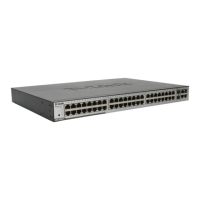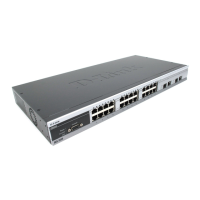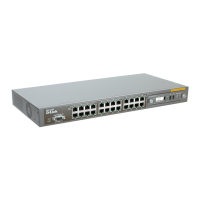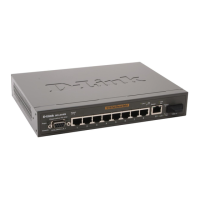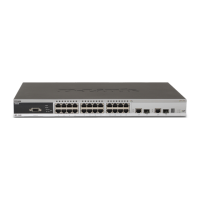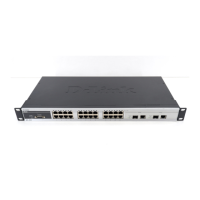DES-3226S Layer 2 Fast Ethernet Switch User’s Guide
84
Broadcast/Multicast Storm Control
Broadcast and Multicast storms consist of broadcast or multicast packets that flood and/or are looped on a network causing
noticeable performance degradation and, in extreme cases, network failure.
The DES-3226S allows some control over broadcast/multicast storms by setting thresholds on the number of
broadcast/multicast packets received (in thousands of packets per second or Kpps), and then following a user-specified course
of action when this threshold is exceeded.
To configure Broadcast/Multicast storm control:
Click on the Forwarding folder, and then on the MAC Forwarding folder, and finally on the Broadcast/Multicast Storm
Control link:
Figure 6 - 61. Broadcast/Multicast Storm Control
Broadcast/Multicast storm control is applied to groups of ports on the DES-3226S. Group 1 contains ports 1 through 8.
Group 2 contains ports 9 through 16. Group 3 contains ports 17 through 24. Group 4 and Group 5 contain the ports on the
optional plug-in module.
The Upper Threshold (Kpps) sets the rate of broadcast or multicast packets received on any of the ports in the corresponding
port group that will trigger the action to be taken by the Switch, as detailed below. A range of thousands of packets received
per second (Kpps) between 0 and 255 can be specified.
When any one of the ports contained within a given port group receives more broadcast or multicast packets per second than is
specified in the Upper Threshold (Kpps) field, the Switch will take the actions specified in the Broadcast Storm Mode,
Multicast Storm Mode, and the Destination Lookup Fail pull-down menus.
The Broadcast Storm Mode is Enabled or Disabled using the pull-down menu for the corresponding port group. When the
Broadcast Storm Mode is enabled, and a port contained within the corresponding port group receives more broadcast packets
than specified in the Upper Threshold (Kpps) field, the Switch will drop all broadcast packets received by any port in the port
group until the rate of broadcast packets received by the port group falls.
The Multicast Storm Mode is Enabled or Disabled using the pull-down menu for the corresponding port group. When the
Multicast Storm Mode is enabled, and a port contained within the corresponding port group receives more multicast packets
than specified in the Upper Threshold (Kpps) field, the Switch will drop all multicast packets received by any port in the port
group until the rate of multicast packets received by the port group falls.
The Destination Lookup Fail is Enabled or Disabled using the pull-down menu for the corresponding port group. When the
Destination Lookup Fail is enabled, and a port contained within the corresponding port group receives more destination
lookup failed packets than specified in the Upper Threshold (Kpps) field, the Switch will drop all destination lookup failed
packets received by any port in the port group until the rate of destination lookup failed packets received by the port group
falls.
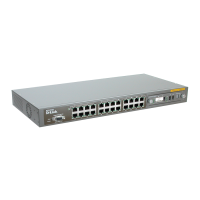
